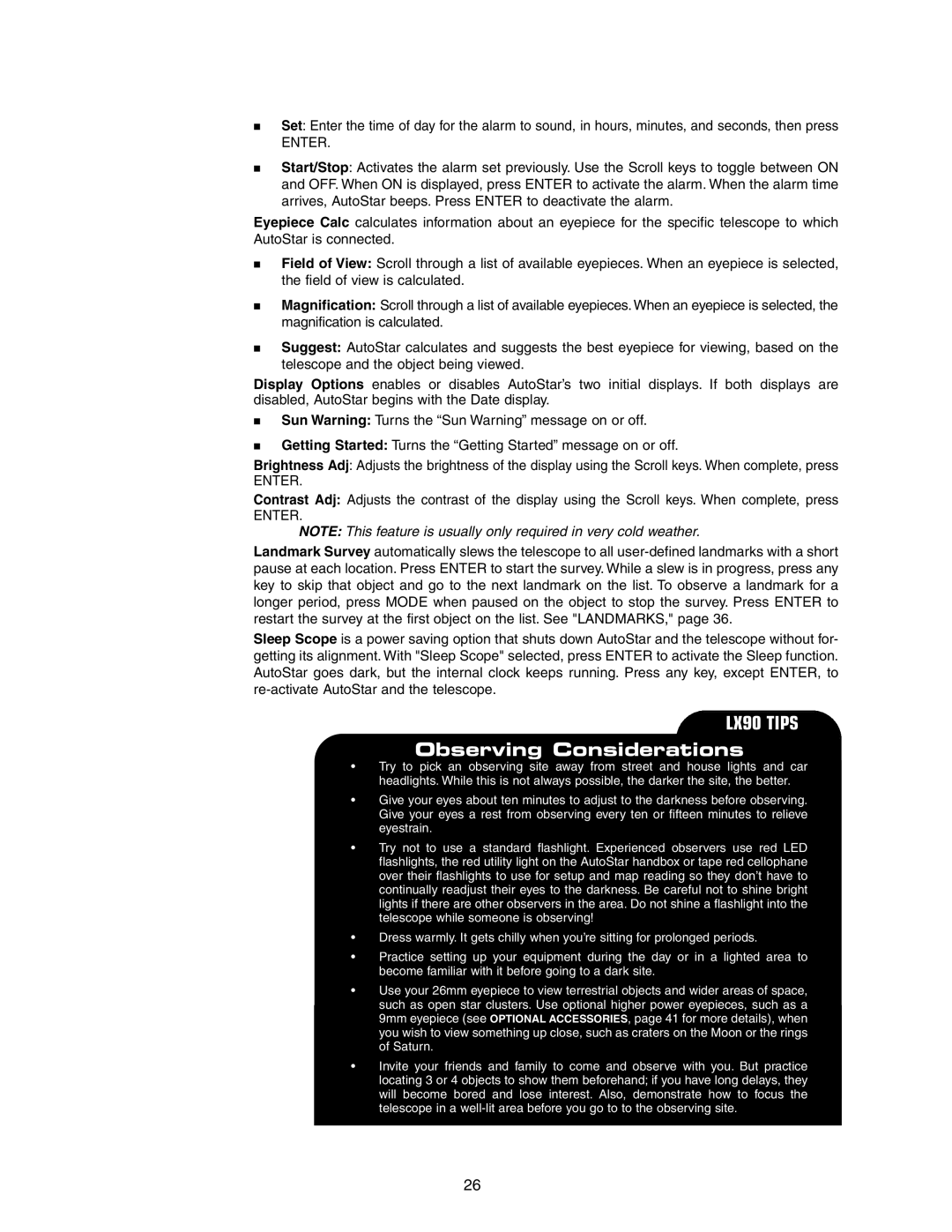
JSet: Enter the time of day for the alarm to sound, in hours, minutes, and seconds, then press
ENTER.
JStart/Stop: Activates the alarm set previously. Use the Scroll keys to toggle between ON and OFF. When ON is displayed, press ENTER to activate the alarm. When the alarm time arrives, AutoStar beeps. Press ENTER to deactivate the alarm.
Eyepiece Calc calculates information about an eyepiece for the specific telescope to which AutoStar is connected.
JField of View: Scroll through a list of available eyepieces. When an eyepiece is selected, the field of view is calculated.
JMagnification: Scroll through a list of available eyepieces. When an eyepiece is selected, the magnification is calculated.
JSuggest: AutoStar calculates and suggests the best eyepiece for viewing, based on the telescope and the object being viewed.
Display Options enables or disables AutoStar’s two initial displays. If both displays are disabled, AutoStar begins with the Date display.
JSun Warning: Turns the “Sun Warning” message on or off.
JGetting Started: Turns the “Getting Started” message on or off.
Brightness Adj: Adjusts the brightness of the display using the Scroll keys. When complete, press
ENTER.
Contrast Adj: Adjusts the contrast of the display using the Scroll keys. When complete, press
ENTER.
NOTE: This feature is usually only required in very cold weather.
Landmark Survey automatically slews the telescope to all
Sleep Scope is a power saving option that shuts down AutoStar and the telescope without for- getting its alignment. With "Sleep Scope" selected, press ENTER to activate the Sleep function. AutoStar goes dark, but the internal clock keeps running. Press any key, except ENTER, to
LX90 TIPS
Observing Considerations
•Try to pick an observing site away from street and house lights and car headlights. While this is not always possible, the darker the site, the better.
•Give your eyes about ten minutes to adjust to the darkness before observing. Give your eyes a rest from observing every ten or fifteen minutes to relieve eyestrain.
•Try not to use a standard flashlight. Experienced observers use red LED flashlights, the red utility light on the AutoStar handbox or tape red cellophane over their flashlights to use for setup and map reading so they don’t have to continually readjust their eyes to the darkness. Be careful not to shine bright lights if there are other observers in the area. Do not shine a flashlight into the telescope while someone is observing!
•Dress warmly. It gets chilly when you’re sitting for prolonged periods.
•Practice setting up your equipment during the day or in a lighted area to become familiar with it before going to a dark site.
•Use your 26mm eyepiece to view terrestrial objects and wider areas of space, such as open star clusters. Use optional higher power eyepieces, such as a 9mm eyepiece (see OPTIONAL ACCESSORIES, page 41 for more details), when you wish to view something up close, such as craters on the Moon or the rings of Saturn.
•Invite your friends and family to come and observe with you. But practice locating 3 or 4 objects to show them beforehand; if you have long delays, they will become bored and lose interest. Also, demonstrate how to focus the telescope in a
26
